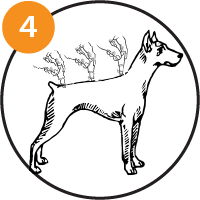Advocate™ topical flea and worm treatment for dogs
Advocate™ topical flea and worm treatment for dogs provides broad spectrum protection from fleas, intestinal worms, ear mites and lice.
Advocate™ kills fleas through contact so they don’t have to bite your dog to die. Plus it also kills flea larvae in your dog’s surroundings.
Safe for use on puppies from 7 weeks of age.
Why choose Advocate™ for your dog?
Fast acting, stopping reinfesting fleas from feeding in 3-5 minutes once contact occurs.
Simple, easy-to-use, monthly spot-on treatment.
Parasite protection inside and out from fleas, worms, ear mites and lice.
How does Advocate™ work?
Monthly parasite protection both inside and out against a broad spectrum of parasites
An easy-to-use spot-on applied monthly, Advocate™ offers parasite protection both inside and out, to help rid your dog of existing parasites and provide ongoing protection.
The active ingredients in Advocate™ provide fast relief from fleas, and help protect your dog from flea larvae, plus intestinal worms including roundworm, hookworm, whipworm, sarcoptic mange, demodectic mange, lice and ear mites.
How to apply Advocate™ on your dog

1. Step
Remove the required tubes from the package. Hold the tube upright and away from you, and pull off the cap.

2. Step
Reverse the cap and push the cap back on the tube. Twist the cap to break the seal and then remove the cap from the tube.

3. Step
For dogs under 25kg, apply one tube between the shoulder blades. Part the hair until the skin is visible. Place the tip of the tube on the skin and squeeze the tube firmly twice to apply the solution directly on the skin.

4. Step
If your dog is larger than 25kg, apply one tube by dividing the dose between the shoulder blades, on the midline of the back between the hips, and at one point in between. For very large dogs over 40kg, apply 2 tubes of Advocate™. Part the hair until the skin is visible. Place the tip of the tube on the skin and squeeze the tube firmly twice to apply the solution directly on the skin.
Directions for use
For easy application, make sure your dog is standing before applying Advocate™. Remove your dog’s collar, and put it back on after the product is dry - except if your dog is wearing a Seresto™ collar. You don't need to remove it when applying Advocate™.
Avoid applying the treatment near the eyes or mouth area as this may cause irritation. Wash your dog before application and apply Advocate™ when your dog is completely dry.
Record the treatment date and repeat monthly or as directed.
Advocate™ flea and worm treatment for puppies and dogs is for external use only. Use on puppies and dogs from 7 weeks of age.
Advocate™ FAQs for dog owners
Advocate, Elanco and the diagonal bar logo are trademarks of Elanco or its affiliates. Advocate™ for dogs is registered under the ACVM Act 1997, No. A009119.
Elanco New Zealand, 106 Wiri Station Road, Manukau, Auckland 2104.
www.elanco.com I 0800 446 121. ©2023 Elanco
+Cruthers LR et al. Suppl Veterinary Forum 2008, 25:3(B):15-20
